Integrations No. 2: Solstice June 2024
An account of my experiences from the edge of the Arctic Circle during 3 days of nonstop light.
This edition of Integrations is a tribute to the behind-the-scenes work that transforms unlikely places into spaces for raving and vinyl DJing. It’s a love letter to the individuals who made the impractical and improbable not just possible, but magnificent at the 2024 Solstice Festival in Finland.
I’ve been meaning to publish this piece for a while, but current events have made it hard to focus. It’s difficult to write about raving with so much grief and chaos in the world. My mind has been filled with images, dialogue, and emotion around the geopolitical. But last weekend was the Solstice, and that felt like the right moment to pause—and to share something from last year’s event that stayed with me.
While I often focus on esoteric ideas in my Substack, this piece also honors the technical effort it takes to elevate an event—to create the conditions for our fleeting moments of freedom and transcendence. The set I played at the festival was, for me, one of my favorite DJing experiences of the last year.
As a DJ who cares about this scene and has put decades into it, I want to start by saying that the events still capture my imagination. I am grateful for music. I appreciate all the people who work behind the scenes. I love dancers. And I say this with a bit of self-consciousness but the truth is that I love what I do and I try to give it my all. For all its contradictions and failures I am still a raver. I am a lifer, for better or worse.
The music and the culture have been a kind of salvation for me and I don’t take that lightly. I am not an optimist. I rely on what thousands of dancers have told me over the last decade: that this thing matters in their life too. Your stories often express a simple love of music and togetherness. Among these conversations are also testimonies of powerful personal transformations. Many of us seem to find some sense of meaning in the music and events, imperfect as that may be.
————
I first heard about the Solstice Festival in 2023 from friends who described it as pure magic. Hyperbole is common in our scene, so it wasn’t just their words—it was the twinkle in their eyes that spoke volumes, conveying a genuine sense of awe and appreciation.
The event is held on Ruka, the mountain and valley of a tiny ski community in Northern Finland called Ruka Kyla (Kyla meaning Village in Finnish). The dates chosen for the event are timed to the Solstice and Midsummer. Ruka is far enough north that the Sun never sets during the course of the four day festival.
As a kid from the Midwest, I never knew it was the summer solstice unless someone told me—at that latitude, even the longest days were still bookended by hours of night. Accordingly, this pilgrimage to Ruka felt truly special. Perhaps a once-in-a-lifetime experience.
In modern usage, the word “festival” is a generic term for an event with music performances. But the idea of a festival is an ancient one, and the word itself originates from medieval religious holidays. While many festivals today are sold as mere entertainment—rooted in the French entretenir, which connotes hospitality and the act of keeping a guest happy—the earliest festivals, by contrast, provided spaces for communal spiritual engagement and release. They were often tied to natural events, including celestial happenings and seasonal transitions. Festivals used to be sacred—I think some still are. And I don’t mean “sacred” as in bestowed by a higher power. I mean “sacred” in the anthropological sense: something a community agrees is set apart from the ordinary, everyday world.
Upon hearing about the Solstice Festival I thought to myself, “Could there be a more fitting event to conjure the Motherbeat?” The Motherbeat is my name for the fundamental pulsation that underlies our music. The solstice has been observed by humans since the Neolithic Era. Part of the message of Motherbeat, and part of why she revealed herself to me, is that rave culture is not the mere byproduct of modern technology and culture. Rather, rave reflects an ancient human desire to dance together for reasons that run deeper than simply hooking up and having fun. Rave is a modern version of an archaic idea: humans use communal dance and music as a way to connect with each other and with nature. Not only the nature around us, but our nature, the manner in which we are part of the earth, the way we come from it, and the way we return to it. Whether the rhythm comes from a sheepskin drum or an oscillator in a drum machine, each source contains the same fundamental pulse when measured on an oscilloscope. The root is the same. The fundamental Source is probably the same. There was a Motherbeat before there were humans. As we literally build ourselves into technology she will still be there as a relic of our humanness.
Much to my delight, in the fall of 2023, I received an offer from the festival to DJ. My excitement was tempered at first because my agent and friend Alex was concerned about me playing for a reason that was entirely pragmatic. The vinyl situation was going to be potentially very challenging. A few weeks earlier a good DJ friend who played in 2023 looked me in the eyes and said “You can’t play there, it won’t work with vinyl.” She was worried about the very intense winds on the mountain and in the valley where the festival is held, even though she had the time of her life there the year prior. Alex was particularly worried about the makeshift stage which is built almost entirely out of wood by the organizers. It is a gorgeous dance floor, but it is suspended on stilts, so it bounces and sways under the feet of all the dancers. Since I play only vinyl and want to make people jump, this setup was likely to be an issue. Getting the decks stable for one of my sets would be difficult, maybe even impossible.
If stability weren’t enough of a challenge, we also had to worry about feedback. The wood itself is highly resonant—many traditional instruments are made from wood because it amplifies and colors sound, adding harmonics to a vibrating source like a string or drum. In this case, the decks were likely to produce feedback as the main speakers and monitors vibrated the wooden surface of the DJ table and dancefloor, sending that resonance back through the needles.
I must admit that hearing that something is “impossible” is like a call to arms for me. This is no ordinary festival. If we could figure out a way I was determined to play. The last thing Alex and I wanted to do was decline for technical reasons and the crew assured us that it would be ok. My very talented tour and production manager Dan Coia and the wonderful team at Solstice started working on a partial redesign of the stage based around a technical rider Dan, Alex, Maya and I have developed over time.
The guiding principle behind the rider is actually very simple, so I’ll endeavor to describe it. To isolate the decks, the best way to do it is to have the turntables on a platform of their own, slightly separated from the dancefloor, the DJ, the main speakers and the monitors. We usually achieve this by putting a small space between the platform for the decks and all the other platforms. The stage is designed so the platform I stand on (which usually also houses the monitors) is separate from the platform holding the DJ table. The platform holding the DJ table is anchored straight down to the earth and doesn’t touch any of the other vibrating surfaces, including the platforms (if any) for the dancefloor and DJ. As everything vibrates and shakes around the decks, there are no skips and no feedback because none of the vibration is transmitted to the decks. The decks are “isolated.”
Normally isolation is relatively easy to achieve with advanced planning. But it was no easy feat for the skilled Solstice crew because the entire dancefloor, powerful main speakers and DJ booth are suspended high up on metal stilts and scaffolding to accommodate the very uneven terrain of the mountain valley where it is set-up. Dan worked with the team over months to try to refine it. Still we were nervous because executing the idea would be tricky. My heart would be broken if I couldn’t deliver at this special event.
My set was Friday night (technically Saturday morning at 00:00) but I began my journey on Wednesday. From my temporary flat in Amsterdam I flew to Helsinki, Finland, which is in the south. I slept at the airport so I could catch the first and only flight on Thursday to Kuusamo, a small airport near the festival. The flight I took was nearly 2 hours straight north towards the Arctic Circle in a small prop plane with maybe 20 or so other ravers. I went a day early so I could be on time for my soundcheck on Friday, which had to be held early in the day since the programming started in the afternoon with a special extended set by Objekt. I also wanted to soak in the surroundings and see for myself what the conditions would be like during my midnight slot the next night.
Peach was playing the same slot as me but on Thursday night. She plays records so I headed to the valley with her from the ski lodge at the base of the mountain to see the setup in action. This was my first real look at the festival site. We saw families of reindeer with baby reindeer on the way up the mountain and so we stopped to take a few pics before we rushed to make her start time.
When we got to the top I felt like a child in awe. My mouth was agape, overwhelmed by the natural surroundings and the details of the production.
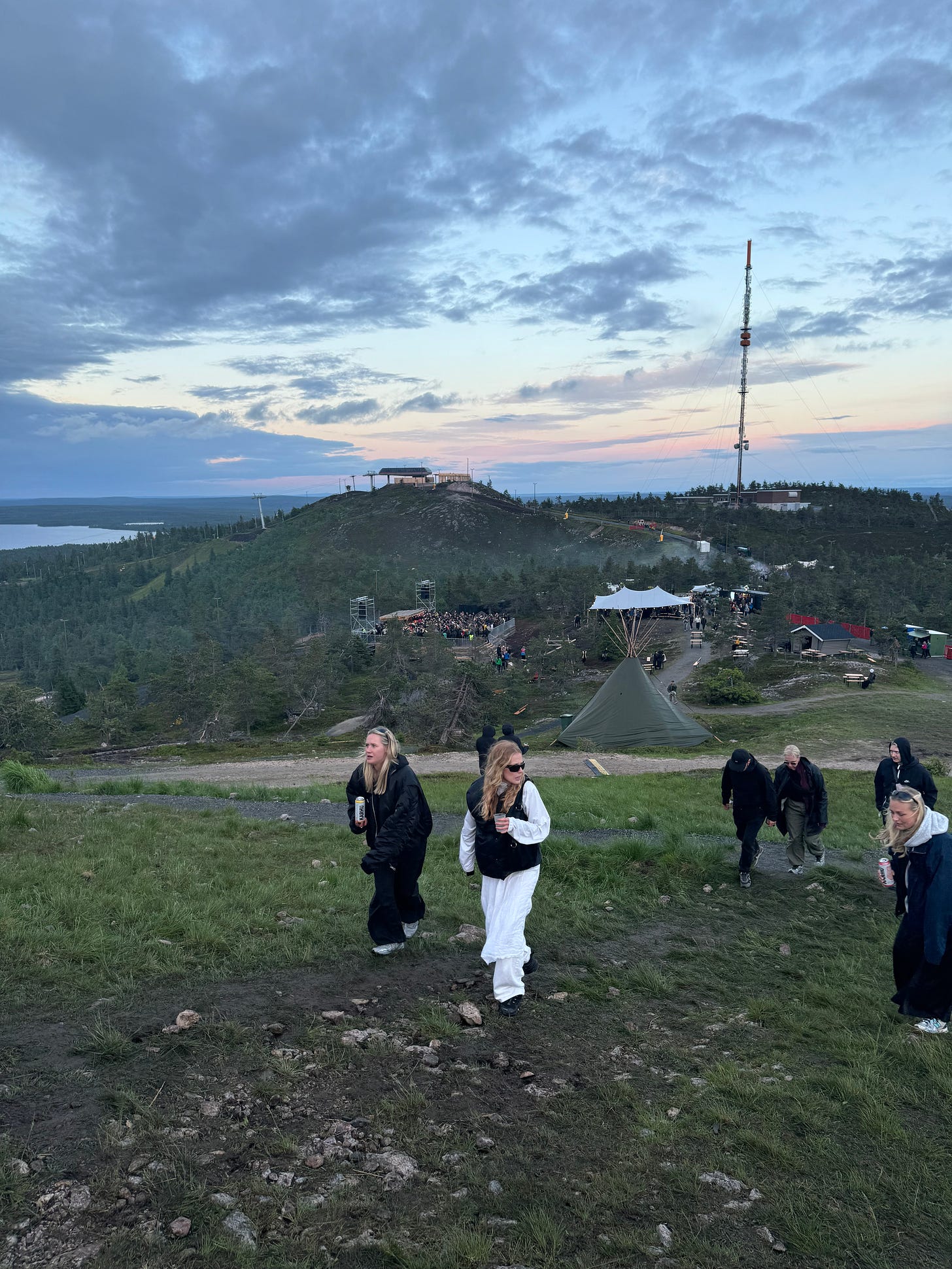
It was inspiring to see how the organizers built the Valley Stage into the natural environment. The 360 views were heart-activating. Peach maneuvered her record bag down a steep muddy (and sort of impossible looking) mountain face with determination. When we got to the stage the cold started to settle into my bones. I danced as the DJ before her, Evan Baggs, played a stunning all-vinyl set of rolling tunes. He didn’t appear to be having technical issues. This was an immediate relief.
The whole contraption was a bit uncanny. The isolated deck platform was swaying in the wind because the stilts under it were very long and it wasn’t secured to any other surface (per the rider). Wind is much smoother than stomping feet and sub bass, so even though the contraption looked really unsteady, the needles were holding the grooves and the whole dj table was swaying as one object. Peach started without any issues. She was playing a proper set, but it wasn’t long before the cold settled into my bones and the muscles of my hands. After an hour or so I headed back to my room.

I treated the next day as a day for preparation and grounding out. Sleep was hard to come by. Describing the endless days of the festival, a new friend said the “Solstice is like being on speed.” I nodded my head in agreement, noting only to myself that I thought a metaphor was more appropriate than a simile. “The Solstice IS being on speed,” I thought to myself.
I’d love to say that I partied into the night with friends old and new, but I didn’t. I often like to have time alone, especially when traveling because I get overstimulated. I am a contemplative person by nature. Most of my childhood was spent alone with my toys or exploring nature. Not much has changed. I love people. And I still love to take psychedelics. But I had my years of Afters and hard drugs. On this night I wanted to get as much sleep as I could. The important thing was to eat a healthy breakfast in the morning and go buy some warm clothes so I wouldn’t freeze my ass off when I played. I also wanted to head to the gym for a proper stretch and workout, organize my records, and do the longest soundcheck I could.

During Peach’s set I noticed that one of the legs of the DJ booth had shifted slightly and was now touching the boards underneath the dancefloor. In the morning I sent a note to the production team requesting that a carpenter meet me at soundcheck and bring a jigsaw to cut the board back slightly so the vinyl players wouldn’t get skips. I also requested that the technician shift the equipment slightly so that the mixer was on its own concrete slab. Sometimes when the mixer shares a slab with a deck, crossfading and other swift movements on a mixer can cause skips. Evan Baggs gave me a heads-up after their set that the decks were mostly stable except for movements from the mixer (Evan told me they had one or two skips caused by moving sliders or knobs on the mixer.) As a tip, it is always good to talk to other DJs about their set. Most of us will focus on the positive when giving feedback to our hosts and the dancers, but we will give a more nuanced take on technical issues to each other. I like the comradery of speaking to other DJs about technical stuff.
When I got to the soundcheck the carpenter had already been there and everything was ready to go. I met Pedro, who is an awesome sound person and we formed an instant bond. Something I’ve come to understand over the years is how hard sound teams work to give us the special experiences we get to have at these events. The hours are long and the conditions to get the sound right are often very very challenging. The sound crews have to negotiate, coordinate, and harmonize each DJ’s technical requests (like choice of mixer), they have to tune the system, and they have to make a thousand other little decisions that affect the night (such as speaker placement).
I recently found out that even changes in humidity cause the sound to change, because water in the air changes the density of the air. Running sound for a festival truly isn’t a “set it and go” situation. Really good sound teams are modern day alchemists, harnessing the power of the elements with technology. It is pure magic when it all comes together right, but I think it is fair to say that their work is often unacknowledged unless something goes wrong. Would be nice if events posted photos of sound crews if they are going to post photos of anyone. I’ve seen many a DJ shoulder—mine own included!
The Solstice team brought in a Danley Sound Labs Sound System. I wasn't expecting it because Danley is a North American manufacturer, so the systems are less common in Europe than back home in the States, where—even there—they are still very much specialized systems. I do like the sound of these speakers. They have an openness that works great for a large dancefloor. Danley speakers disperse the sound evenly and reproduce the top frequencies of hi-hats in a way that few systems can. The mid-range is defined and has depth, meaning that sounds mixed more quietly in a recording (softer sounds) still have presence within the depth of field the speakers are able to voice. These Danley speakers are a good transmitter of the information on my records, which are quieter but have far more dynamics than digital files.
I took a little extra time at soundcheck. After going through all my necessary technical steps (an extensive list I plan to share in a future column), I stuck around to listen—just to hear how different records sounded on the system and how they felt in the natural amphitheater of the mountain valley. Already, I could feel the whisper of the Motherbeat all around me. My heart was open. DJ Marcelle arrived for her sound check, and I immediately stopped the track that was playing and got out of her way. Back to base camp.
I tried to sleep after the soundcheck but my mind was racing and I was genuinely excited. I settled on the strategy for my 2-hour closing set. I would start with some bright piano hardcore and Nu Skool breaks to get everyone’s body activated and warm after a long cold day, after which I would move into some rolling prog and housey trance to open everyone's hearts and hopefully evoke the archetype of the Motherbeat in the music. She is a symbol as much as she is a thing. I knew the Sun would be held in the position of a sunset as I played my last records, cresting on the horizon but never disappearing behind it. A symbol of the suspension of time we all experienced.
With my plan established, I decided to do a little research online because someone had tipped me off that my set (from midnight until 2 am) was at the start of the true midsummer; the start of the longest day. In scientific terms, midsummer is the day that the Earth’s poles are most extremely inclined towards the star we orbit. Solstice is defined by solar declination - the latitude of Earth where the sun is directly overhead at noon. During the solstice the sun’s apparent path is farthest north or south from Earth’s equator. The further north you go during the summer solstice, the longer the day. The further south, the shorter. The coordinates (latitude and longitude) of Ruka are 66.1651° N, 29.1572° E.

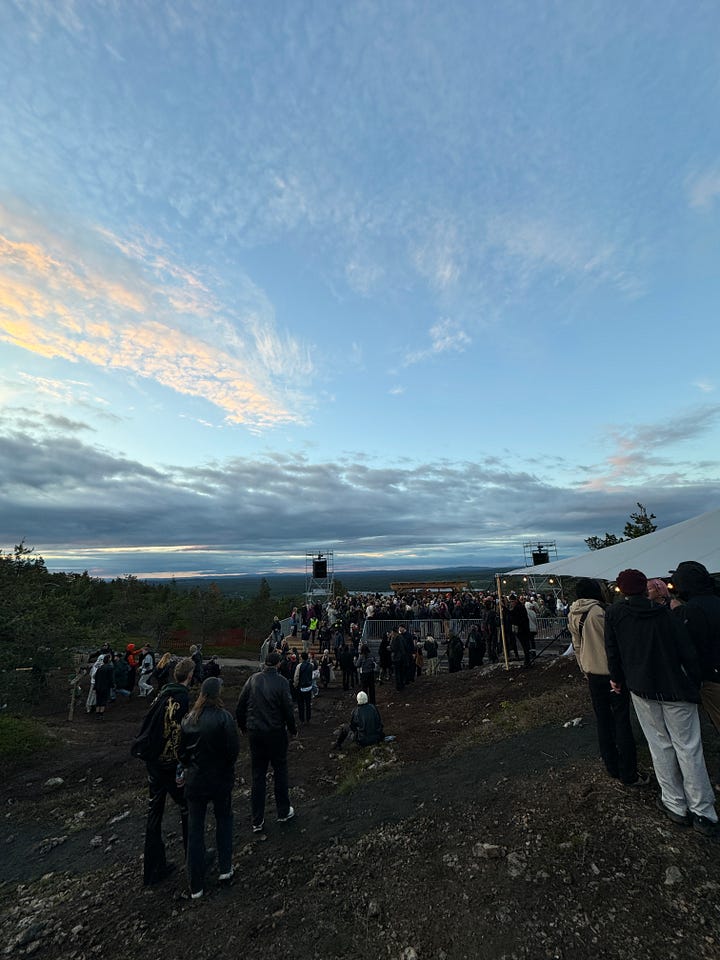
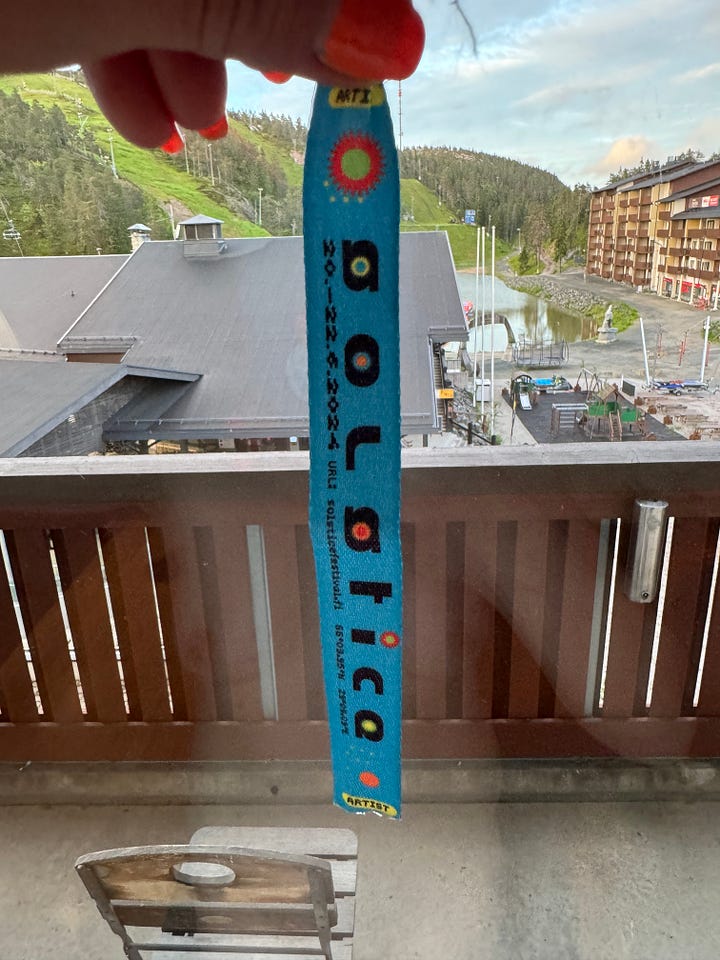
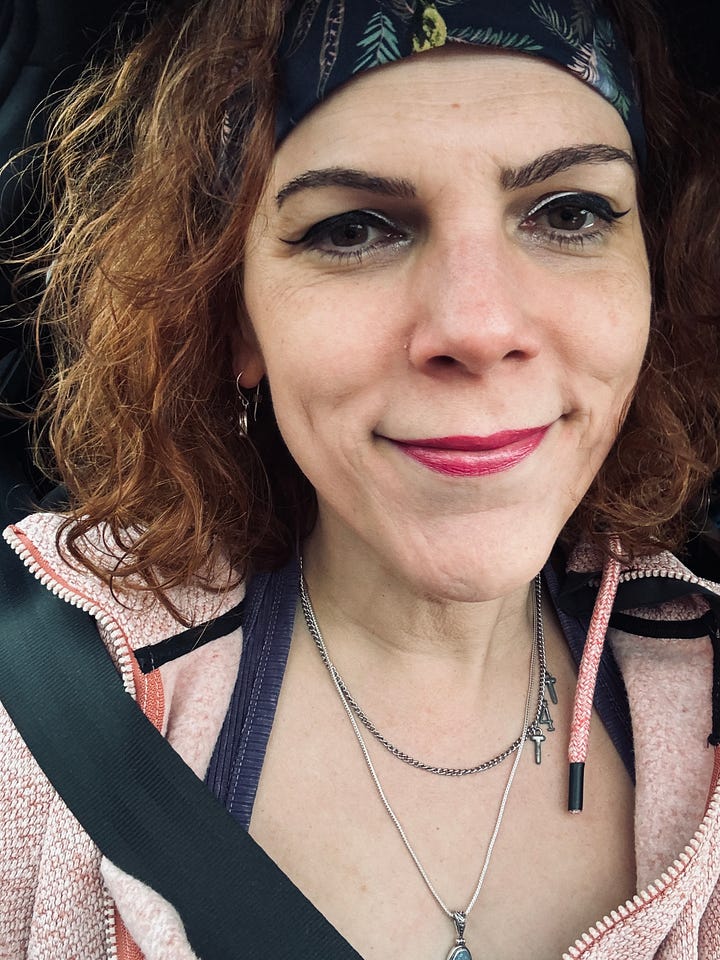
As I climbed the mountain for my set my mood was lightened by my driver who was very sweet and hyped up. He had been timing his ascents and descents from the peak to the town and was intent on setting his record with me in the car. My adrenaline rushed as I opened my eyes as wide as I could to spot any reindeer or other animals that might be trying to cross our path as we zoomed up the mountain. I saw a big rabbit jump in the forest. It was like a dinosaur compared to the little bunnies we have in North America.
DJ Marcelle played before me. She is also an all-vinyl DJ. As she played her last record— a 45 with so many pops they formed a rhythm much to her delight—I noticed she had the gains on all the channels and the master turned all the way up. She’s an amazing agent of chaos, which I genuinely appreciate, but I was worried about feedback and distortion on my loud dance records if I kept the levels that high. I spoke to the engineer to ask for his help in the beginning 30 seconds of my set. To get my tracks out of the red I would need to turn all the gains down on the channels. The only way the floor would not experience this reduction in volume as a drop in energy would be if the engineer turned up the mixer output on his live sound mixer at the same time to compensate.
The first moments of the set were honestly a bit awkward as I reset the mixer (my fault not his). But by the first piano break—32 bars into my opening track—the dancefloor erupted in a fit of collective euphoria. We were off to the races. My fingers were already numb from the cold but I was determined to mix my ass off so I kept the pressure on and did a 16 bar mix to “hard cut” to a Yo Speed! record I got a few weeks earlier. It isn’t every dance floor that will go off to breaks, but I am always determined to push that part of my sound. I was delighted when the energy went through the roof on the second track. The blend was tight and arranged nicely so I felt a surge of confidence and joy.
The decks were swaying in the wind, which I had to counteract by being really gentle with my adjustments to the pitch sliders. I also had to be graceful with my cues and scratches—any torque would cause a skip. Over time, I’ve come to the conclusion that being delicate in these intense moments actually can make a person a better player. It forces some part of the brain to become extra aware, and time begins to slow down in my perception. It’s a special flow to enter, and it doesn’t happen every time. I had to fully trust the situation—being guided by the sway of the decks rather than resisting it. I had to let go. Any tension or resistance in my movements would result in a skip or a skid. Like pushing a stone with a feather, I tried to drive powerful transitions and other musical moments with gentle, thoughtful touch. In moments of pause, I let the songs play and danced with everyone—but not for too long, since I wanted to keep the pace flowing. The sound engineer, who was working hard too, finally took a moment to headbang to a proper rave tune, which made me smile a soulful smile and follow suit in unison. The energy between me as the DJ and the people dancing was cyclic, and every last person was involved in raising the vibe.
As we entered the second hour I started to play more radiant tracks with longer arrangements. I dropped in simple but serious positive messages and familiar signals…”L, L, L, Listen… Don’t Stop.” I had one rough mix into a Tin Tin Out track because of a small skip while I was mixing in the record. I re-cued the track and completed the blend. I do everything I can to minimize mistakes which break the flow of the beat and tension of the blends, but technical issues and how you respond to them are as much a part of the art of the mix as anything else. Even the most experienced tightrope walker sometimes teeters on the rope; the possibility of falling off is part of what makes the performance exciting, and human. This tension is part of why vinyl DJing is so special.
At this point in the set, a musician pal offered me mushroom drops. Before the set I told him that I would love to take them in the last hour. But in the moment I ended up declining because everything was so perfect and I felt I was playing near my peak of technical ability. I use the mushroom when I play sometimes to perturb my rational mind and connect my heart after intense travel or tiring days, but my system was in a good place so I stuck to my menu of maté and sparkling water. If it aint broke, don’t fix it.
There was only one record I brought specifically for the set. Months before I made the pilgrimage to Ruka, I decided I wanted to play the Orbital Mix of “A Huge Ever Growing Pulsating Brain That Rules from the Centre of the Ultraworld” by the Orb (aka “Loving You”). The track feels like an expanding sun, and I imagined the message in the lyrics—along with the animal sounds—as the voice of the Motherbeat herself.
“Loving you is easy 'cause you’re beautiful, and everything that I do is all because of you.”
The transmutation of the romantic into the universal is part of the rapture of Motherbeat, and it’s something I try to express through my DJing and track selection. I call this interpretive technique Reverse Double Entendre1—when a song about romantic love opens outward into a more generalized, collective love. When we expand the meaning of a song into this secondary domain, love has no subject and no object. It gestures toward universal ideas: unity, nature, togetherness, nurturing, and giving—including the quiet, necessary act of being gentle with yourself.
As I closed the set with this beautiful song I tried to take in the subjective moment. Even if I return to Solstice, I will never relive that moment with those people on that revolution around the Sun. The dancefloor was filled with the most open and gracious ravers dancing into an eternal sunset, cold but ecstatic, having traveled from places far and wide with the intent to dance together at this special celestial event. We felt alive. We felt a kind of togetherness.2 Imperfect, ineffable and fleeting, but also real, emergent, and unforgettable. I mixed in my decommissioned train whistles as I faded out the Orb, signaling the transition from one space and state of being to another.
While I packed my records I passed around strawberries to the ecstatic dancers and talked with people who stayed behind to process the set and just say hi. Once my records were put away I took a last look around, giggled with new pals, and headed towards my ride. Earlier in the night a fellow artist told me he “50% believes” in reference to the spiritual messages in this Substack. I explained to him I wasn’t trying to make him believe anything (except maybe that I was being sincere) but the comment stayed with me. I thought to myself, it isn’t about belief, it is about experience. To go to Solstice is to experience something extraordinary in the theater of the eternal sun.
I couldn’t help but call down to him as I walked towards the car. I don’t know if he heard me. “Motherbeat is real!!!” She is in my life and in the lives of others. Call her whatever you want. Don’t give her a name. It doesn’t really matter. And it certainly doesn’t matter to me. Music transcends ideology and language. Music is older than we are. If we let it, we can use it to unlock our bodies. To heal old wounds. To in some sense dissolve the dominant cultural paradigms which often dictate so many of our priorities. We can use music to connect with nature. And to find each other.
Music is not the cure to life’s problems, but in a world of suffering and incomprehensible complexity, a personal subjective relationship with music can help us to feel alive and connect with others—maybe even motivate us to resist. Mother is indeed mothering, if we let her.
Massive respect to the Solstice organizers, crew, staff and volunteers —- your work is extraordinary in the true sense of the word.
A huge thanks to Dan, Alex and Maya for your expertise, for believing in me, and for caring about vinyl playing as much as you do. Nothing I do is possible without you.
- Eris Drew
Whereas a traditional double entendre draws out hidden sexual meaning from ordinary language, a Reverse Double Entendre takes something intimate—usually romantic love—and expands it into a broader field of connection: collective, spiritual, ecological, or cosmic. It’s a technique of sublimation and expansion, not innuendo.
This idea of togetherness is explored beautifully in Together, Somehow: Music, Affect, and Intimacy on the Dancefloor by Luis Manuel Garcia-Mispireta (Duke University Press, 2023).







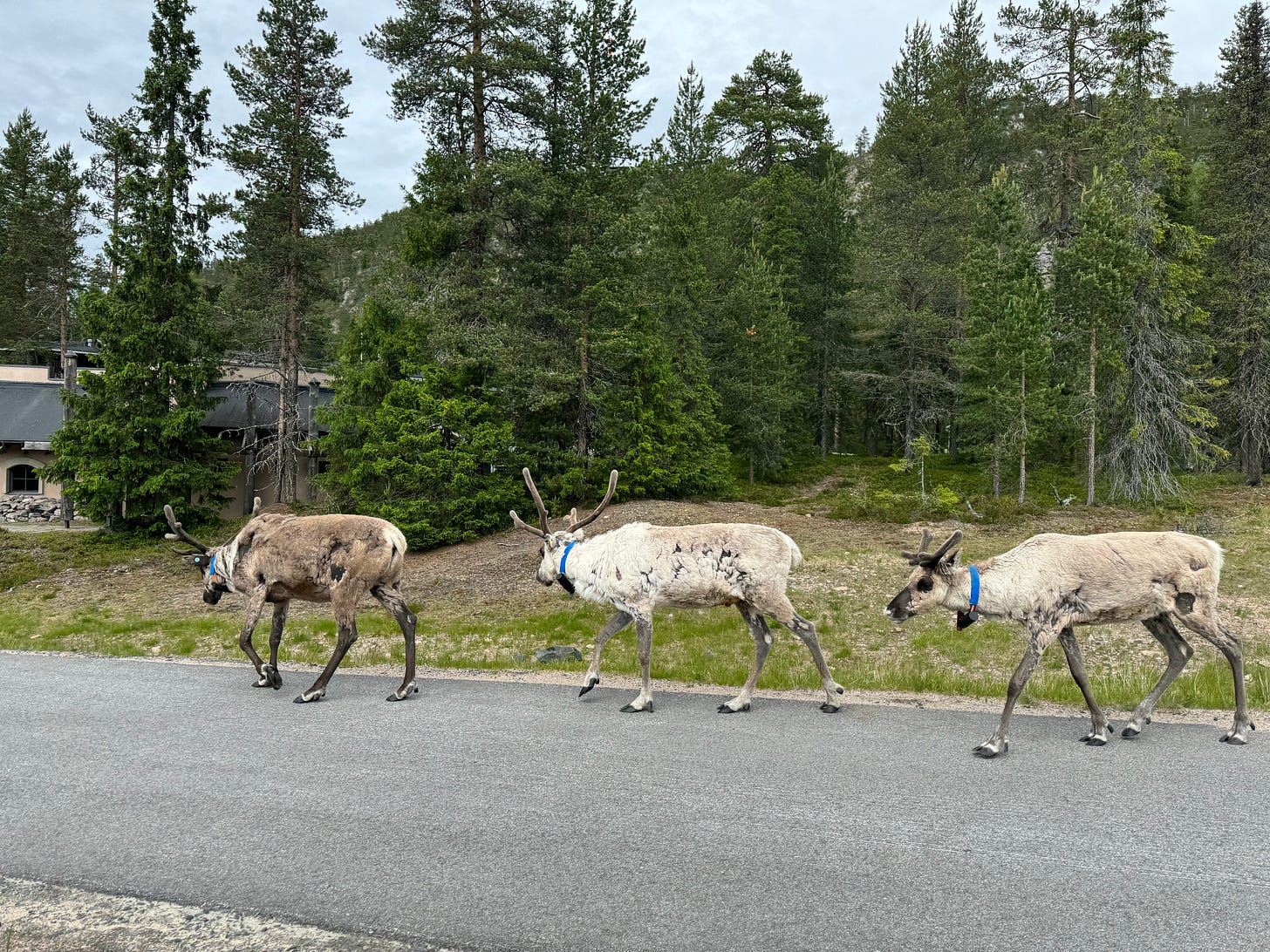



Extremely inspiring, thank you for sharing. I love the blend of the technical and the ecstatic, for example with the information about the rider as well as the personal processing of the experience...thank you for always weaving those threads together. I didn't have FOMO reading this like I thought I would. Rather I just really enjoyed reading it, and I was reminded that my communal musical experiences are indeed very special. Love the newsletter, love the music, thank you!
Gosh, what a beautifully written piece of human essence with nature, I love it, Eris. This reminded of me reading Laurent Garnier's "Electrochok" a long time ago where he talks about everyone's mother heartbeat being the first sound every person listens to in their life, even before we're born. That's just one of the infinite versions of the Motherbeat, it does indeed exist, everywhere, it's incredibly primitive, subtle and fundamental. Thank you for being such a special human being and for spreading music with such thoughtfulness and love.